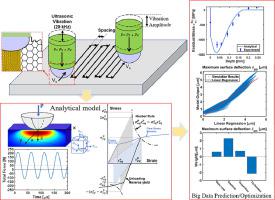International Journal of Mechanical Sciences ( IF 7.1 ) Pub Date : 2021-01-24 , DOI: 10.1016/j.ijmecsci.2021.106307 Jingyi Zhao , Yalin Dong , Chang Ye

|
In this work, we have developed a fast and robust analytical model based on the Hertzian contact theory and the Neuber's plasticity law to predict the residual stress generated by ultrasonic nanocrystal surface modification (UNSM). The measured residual stresses data for a number of different metals was used to validate the analytical model. Sensitivity studies as well as the linear regression analysis were conducted to study the effects of UNSM parameters (striking amplitude, static load, spacing, scanning speed and temperature) on the distribution of residual stresses and the surface finish. The analysis shows that a balance between residual stress and surface finish needs to be considered when choosing the UNSM parameters: the increase of ultrasonic striking amplitude and static load improve the magnitude and depth of the residual stress at the risk of deteriorating the surface finish; a higher temperature leads to a lower magnitude but deeper residual stress as well as a better surface finish; smaller tip size can significantly increase the magnitude of residual stresses but it also deteriorates the surface finish. Finally, an experimental design based on a large database (with a total of 18876 sets of UNSM parameters) was introduced to find the optimal UNSM parameters for different engineering needs.
中文翻译:

通过分析模型和数据驱动的预测优化超声纳米晶表面改性产生的残余应力
在这项工作中,我们基于赫兹接触理论和诺伊伯可塑性定律开发了一种快速而强大的分析模型,以预测超声纳米晶体表面改性(UNSM)产生的残余应力。测得的多种不同金属的残余应力数据用于验证分析模型。进行了敏感性研究和线性回归分析,以研究UNSM参数(冲击幅度,静载荷,间距,扫描速度和温度)对残余应力分布和表面光洁度的影响。分析表明,在选择UNSM参数时,需要考虑残余应力和表面光洁度之间的平衡:超声冲击幅度和静载荷的增加改善了残余应力的大小和深度,但有使表面光洁度恶化的风险;较高的温度导致较低的强度,但残余应力更深以及表面光洁度更好。较小的尖端尺寸可显着增加残余应力的大小,但同时也会降低表面光洁度。最后,基于大型数据库(总共18876组UNSM参数)的实验设计被引入,以找到满足不同工程需求的最佳UNSM参数。较小的尖端尺寸可显着增加残余应力的大小,但同时也会降低表面光洁度。最后,基于大型数据库(总共18876组UNSM参数)的实验设计被引入,以找到满足不同工程需求的最佳UNSM参数。较小的尖端尺寸可显着增加残余应力的大小,但同时也会降低表面光洁度。最后,基于大型数据库(总共18876组UNSM参数)的实验设计被引入,以找到满足不同工程需求的最佳UNSM参数。











































 京公网安备 11010802027423号
京公网安备 11010802027423号